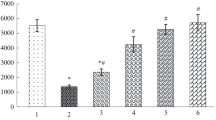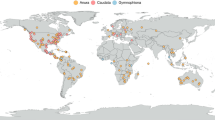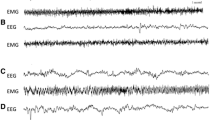Summary
-
1.
Measurements of oxygen consumption and lactate production during activity were made in three species of amphibians. Oxygen debts and rates of lactate removal were also studied.
-
2.
Maximal values of oxygen consumption are 200 and 500% above resting levels in the plethodontid salamanderBatrachoseps attenuatus and the frogHyla regilla, respectively (Kg. 1). However, these values are not attained until 5–15 min after the cessation of activity.
-
3.
Batrachoseps, a lungless animal, derives 25 times more energy during 2 min of activity from lactate production than from oxygen consumption.Hyla is also predominantly anaerobic during activity butBufo boreas is mainly aerobic.
-
4.
An inverse relationship exists between aerobic and anaerobic scopes in amphibians, such that total energetic output during activity is similar even though the component factors may differ by ten-fold.
-
5.
Oxygen debts inHyla andBatrachoseps after 2-min activity are repayed in approximately one hour but rates of lactate removal are much lower (Fig. 2); large amounts of lactate persist long after oxygen consumption has returned to resting levels. Oxygen debt, therefore, cannot be used as an estimate of energetic expenditure during activity.
Similar content being viewed by others
References
Bennett, A. F.: Blood physiology and oxygen transport during activity in two lizards,Varanus gouldii andSauromalus hispidus. Comp. Biochem. Physiol.46A, 673–690 (1973)
Bennett, A. F., Dawson, W. R.: Aerobic and anaerobic metabolism during activity in the lizardDipsosaurus dorsalis. J. comp. Physiol.81, 289–299 (1972)
Bennett, A. F., Dawson, W. R.: Metabolism. In: Biology of the Reptilia. Physiology A, vol. 5, ed. C. Gans. New York: Academic Press, in press 1974
Bennett, A. F., Licht, P.: Anaerobic metabolism during activity in lizards. J. comp. Physiol.81, 277–288 (1972)
Bennett, A. F., Licht, P.: Anaerobic metabolism during activity in amphibians. comp. Biochem. Physiol., in press (1974)
Bennett, A. F., Wake, M.: Metabolic correlates of activity in the caecilianGeotrypetes seraohinii. Copeia1974, in press (1974)
Black, E. C., Robertson, A. C., Parker, R. R.: Some aspects of carbohydrate metabolism in fish, p. 89–124. In: Comparative physiology of carbohydrate metabolism in heterothermic animals, ed. A. W. Martin. Seattle: University of Washington Press 1961
Brett, J. R.: The metabolic demand for oxygen in fish, particularly salmonids, and a comparison with other vertebrates. Resp. Physiol.14, 151–170 (1972)
Brooks, G. A., Hittelman, K. J., Faulkner, J. A., Beyer, R. E.: Temperature, skeletal muscle mitochondrial functions, and oxygen debt. Amer. J. Physiol.220, 1053–1059 (1971a)
Brooks, G. A., Hittelman, K. J., Faulkner, J. A., Beyer, R. E.: Tissue temperatures and whole-animal oxygen consumption after exercise. Amer. J. Physiol.221, 427–431 (1971b)
Buddenbrook, W. von: What physiological problems are of interest to the marine biologist in his studies of the most important species of fish? II. Beobachtungen über das Sterben gefangener Seefische und über den Milchsäuregehalt des Fischblutes. Int. Coun. Explor. sea, Rapp. Proc.-Verb.101, 3–7 (1938)
Cerretelli, P., di Prampero, P. E., Ambrosoli, G.: High-energy phosphate resynthesis from anaerobic glycolysis in frog gastroonemius muscle. Amer. J. Physiol.222, 1021–1026 (1972)
Fry, F. E. J.: Effects of the environment on animal activity. Pub. Ont. Fish. Res. Lab. No.68, 1–62 (1947)
Heath, A. G., Pritchard, A. W.: Changes in the metabolic rate and blood lactic acid of bluegill sunfish,Lepomis macrochirus, Raf. following severe muscular activity. Physiol. Zool.35, 323–329 (1962)
Hutchison, V. H., Whitford, W. G., Kohl, M.: Relation of body size and surface area to gas exchange in anurans. Physiol. Zool.41, 65–85 (1968)
Karpovich, P. V.: Physiology of muscular activity, 5th ed. Philadelphia: W. B. Saunders Co. 1959
Moberly, W. R.: The metabolic responses of the common iguana,Iguana iguana, to activity under restraint. Comp. Biochem. Physiol.27, 1–20 (1968)
Secondat, M.: Influence de l'exercice sur la capacité pour l'oxygène du sang de la Carpe (Cyprinuscarpio L.). C.R. Acad. Sci. (Paris)230, (1950)
Seymour, R. S.: Physiological correlates of forced activity and burrowing in the spadefoot toad,Schaphiopus hammondii. Copeia1973, 103–115 (1973)
Whitford, W. G., Hutchison, V. H.: Gas exchange in salamanders. Physiol. Zool.38, 228–242 (1965)
Whitford, W. G., Hutchison, V. H.: Body size and metabolic rate in salamanders. Physiol. Zool.40, 127–133 (1967)
Author information
Authors and Affiliations
Additional information
Support for these studies was provided by a Miller Postdoctoral Fellowship to AFB and NSF Grant GB-35241X to PL. The technical assistance of John Ruben is gratefully acknowledged.
Rights and permissions
About this article
Cite this article
Bennett, A.F., Licht, P. Relative contributions of anaerobic and aerobic energy production during activity in amphibia. J. Comp. Physiol. 87, 351–360 (1973). https://doi.org/10.1007/BF00695269
Received:
Issue Date:
DOI: https://doi.org/10.1007/BF00695269




